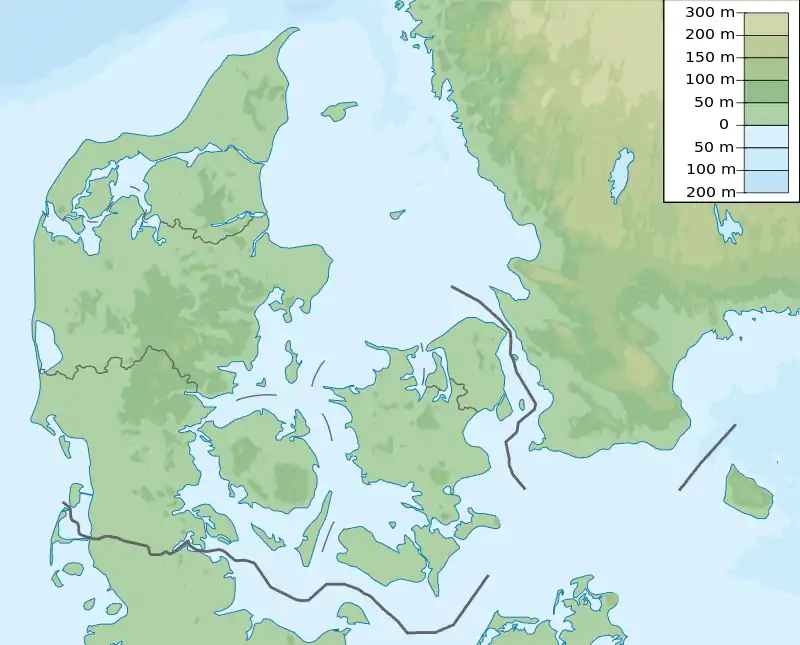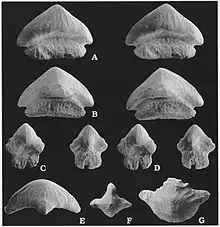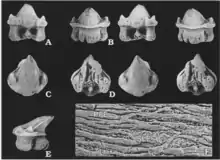Hasle Formation
The Hasle Formation is a geologic formation on the island on Bornholm, Denmark. It is of early to late Pliensbachian age. Vertebrate fossils have been uncovered from this formation.[1][2]
| Hasle Formation Stratigraphic range: Pliensbachian ~185 Ma | |
|---|---|
| Underlies | Sorthat Formation |
| Overlies | Rønne Formation |
| Thickness | 80–140 m (260–460 ft) |
| Lithology | |
| Primary | Siltstone, sandstone |
| Location | |
| Coordinates | 55.2°N 14.7°E |
| Approximate paleocoordinates | 45.0°N 18.5°E |
| Region | Bornholm |
| Country | |
 Hasle Formation (Denmark) | |
Fossil content
Fish
Unidentified fin spines are known from this formation.[1]
| Genus | Species | Material | Notes | Images |
|---|---|---|---|---|
|
Hybodus reticulatus[1] |
21 incomplete crowns |
A marine shark, type member of the family Hybodontidae inside Hybodontiformes. |
 | |
|
Hybodus delabechei[1] |
Three complete crowns |
A marine shark, type member of the family Hybodontidae inside Hybodontiformes. It´s teeth of suggest that it may have been feeding on shelly invertebrates. | ||
|
Hybodontidae Indeterminate |
One incomplete spine |
A marine shark, Incertade sedis inside Hybodontiformes. |
||
|
Lissodus hasleensis[1] |
Four complete teeth |
A marine shark, member of the family Lonchidiidae inside Hybodontiformes. |
 | |
|
Synechodus occultidens[1] |
Four incomplete teeth |
A marine shark, type member of the family Paleospinacidae inside Synechodontiformes. |
||
|
Paraorthacodus sp[1] |
Two incomplete teeth |
A marine shark, member of the family Paleospinacidae inside Synechodontiformes. |
||
|
Agaleus dorsetensis[1] |
Four teeth |
A marine shark, type member of the family Agaleidae inside Euselachii. This genus may have been a suction feeder as its anterior teeth are similar to those of extant nurse sharks. |
 | |
|
Oblidens[3] |
Oblidens bornholmensis[3] |
Upper posterior (palatine) and lower posterior (mandibular) tooth plates. |
A marine Chimaera, member of the family Myriacanthidae inside Chimaeriformes. |
 |
|
Myriacanthus sp.[3] |
Isolated tooth plate |
A marine Chimaera, type member of the family Myriacanthidae inside Chimaeriformes. |
||
Sauropterygia
| Genus | Species | Material | Notes | Images |
|---|---|---|---|---|
|
Tooth |
A marine plesiosaur, member of the family Plesiosauroidea inside Sauropterygia. |
||
|
|
A marine plesiosaur, member of the family Plesiosauroidea inside Sauropterygia. |
||
|
Tooth |
A marine plesiosaur, member of the family Rhomaleosauridae inside Sauropterygia. Resembles Rhomaleosaurus. |
||
|
Fourteen isolated teeth |
A marine plesiosaur, member of the family Pliosauroidea inside Sauropterygia. Resembles Attenborosaurus. |
||
Theropods
| Genus | Species | Material | Notes | Images |
|---|---|---|---|---|
|
Stenonyx isp. |
25 mm footprints referred to a non-avian Theropod.[7] |
Theropod Tracks, member of the ichnofamily Anchisauripodidae, incertade sedis inside Theropoda. Considered a very Small Dinosaur, probably a juvenile. The Foot resembles those of young Coelophysis from Ghost Ranch Quarries.[7] Stenonyx footprints had been described from the Early Jurassic Soltykow (Hettangian) and Szydlowek, what matches with specimens found on the Hasle Formation, linking Southern Sweden, Bornholm and Poland, contiguous during the Early Jurassic and dinosaurs could thus freely roam this large area.[7] |
||
Sauropodomorpha
| Genus | Species | Material | Notes | Images |
|---|---|---|---|---|
|
Massopoda Indeterminate |
DK966, an upper part of a femur from a juvenile animal |
A Massopoda Sauropodomorph. DK966 has been compared with various taxa from the lower jurassic: "Aristosaurus erectus", a young Massospondylus, various Massospondylus specimens, Lufengosaurus huenei holotype, Seitaad ruessi, Thecodontosaurus, Pantydraco, etc. DK966 can be probably a young specimen of Massopoda, related to Massospondylus, more than a Plateosaurid or an Anchisaurid. We find it related to "Hortalotarsus", "Aristosaurus" and Massospondylus more than Seitaad for example. Based on the several taxa we had compared probably presented a body similar to Pantydraco being a young specimen. The complete bone is estimated on only 6 cm, making the animal no more than 70 cm length. |
||
Ammonites
| Genus | Species | Material | Notes | Images |
|---|---|---|---|---|
|
A. centaurus[2] |
specimens[2] |
Later renamed Beaniceras centaurus, senior synonym of Aegoceras centaurus[2] |
||
|
A. armatum[2] |
specimens[2] |
|||
|
A. capraius[2] |
specimens[2] |
|||
|
A. mangenesti[2] |
specimens[2] |
|||
|
A. pettos[2] |
specimens[2] |
Junior synonym of Coeloceras pettos, possible synonym of Coeloceras grenouillouxi[2] |
||
|
Uncertain |
? Acanthopleuroceras sp. indet.[2] |
specimens[2] |
||
|
Apderoceras[2] |
A. aculeatum[2] |
specimens[2] |
||
|
A. falcaries[2] |
specimens[2] |
|||
|
B. centaurus[2] |
specimens[2] |
Senior synonym of Aegoceras centaurus[2] |
||
|
Coeloceras[2] |
C. pettos[2] |
specimens[2] |
Senior synonym of Aegoceras pettos. Possible junior synonym of Coeloceras grenouillouxi[2] |
|
|
C. grenouillouxi[2] |
specimens[2] |
Possible senior synonym of Coeloceras pettos[2] |
||
|
Paramicroderoceras[2] |
P. fila[2] |
specimens[2] |
||
|
P.? sp indet[2] |
specimens[2] |
|||
|
P. losconnbii[2] |
specimens[2] |
|||
|
Phricedoceras[2] |
P. taylori[2] |
specimens[2] |
||
|
Platypleuroceras[2] |
P. brevispina[2] |
specimens[2] |
||
|
P. submulticum[2] |
specimens[2] |
|||
|
P. caprarium[2] |
specimens[2] |
|||
|
P. spp. indet[2] |
specimens[2] |
|||
|
R. hechingense[2] |
specimens[2] |
|||
|
Tragophyloceras[2] |
T. numismale[2] |
specimens[2] |
||
|
T. sp[2] |
specimens[2] |
|||
|
U. lata[2] |
specimens[2] |
|||
|
U. sp indet[2] |
specimens[2] |
|||
References
- Rees, J. (1998). "Early Jurassic selachians from the Hasle Formation on Bornholm, Denmark" (PDF). Acta Palaeontologica Polonica. 43 (3): 43–439.
- Donovan, Desmond T. & Surlyk, Finn. "Lower Jurassic (Pliensbachian) ammonites from Bornholm, Baltic Sea, Denmark" (PDF). Geological Survey of Denmark and Greenland Bulletin. 1: 555–583.CS1 maint: uses authors parameter (link)
- Christopher J. Duffin; Jesper Milàn (2017). "A new myriacanthid holocephalian from the Early Jurassic of Denmark" (PDF). Bulletin of the Geological Society of Denmark. 65: 161–170.
- Bonde, N., Andersen, S., Hald, N., & Jakobsen, S.L. 2008: Danekræ – Danmarks bedste fossiler, 225 pp. Gyldendal, Copenhagen.
- Rees, J., & Bonde, N. (1999). Plesiosaur remains from the Early Jurassic Hasle Formation, Bornholm, Denmark. Secondary Adaptation to Life in Water, Copenhagen, 13-17.
- Smith, A. S. (2008). Plesiosaurs from the Pliensbachian (Lower Jurassic) of Bornholm, Denmark. Journal of Vertebrate Paleontology, 28(4), 1213-1217.
- Jesper Milàn, Finn Surlyk. 2014: An enigmatic, diminutive theropod footprint in the shallow marine Pliensbachian Hasle Formation, Bornholm, Denmark
- Geocenter DK (2020):Hasle Formationen. Aviable at:https://www.geocenter.dk/geoviden/dedanskedinosaurer/hasle-formationen/
- Milàn, J., Cuny, G. (2019):Knogle fra mini sauropod fundet ved Hasle. Geomuseum Faxe Danmark. University of Lyon Frankrig. https://www.researchgate.net/publication/332291953_Knogle_fra_mini_sauropod_fundet_ved_Hasle